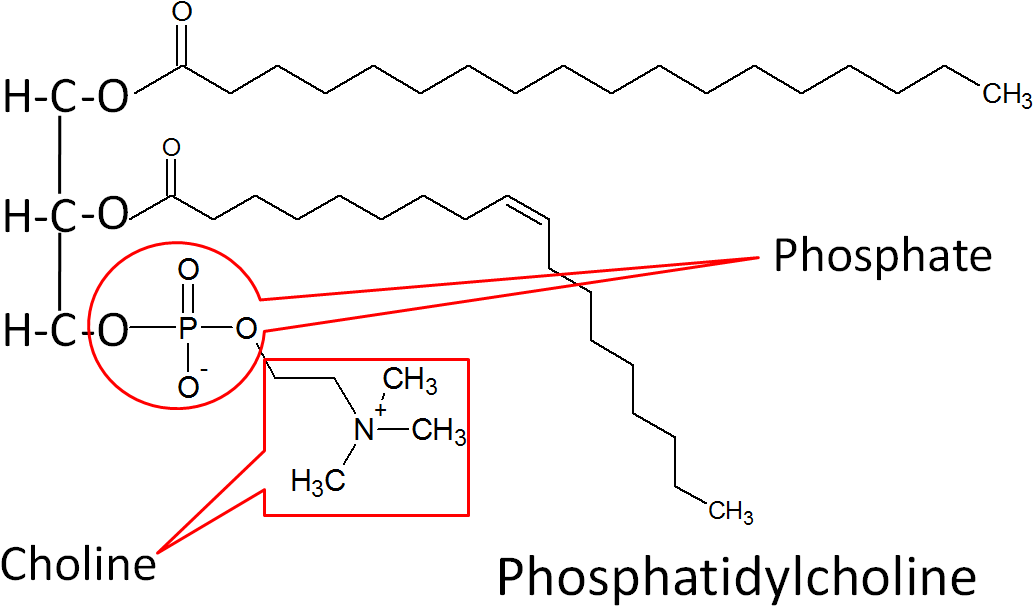Phospholipids are similar in structure to triglycerides, with the only difference being a phosphate group and nitrogen-containing compound in the place of a fatty acid.

Figure 2.361 Structure of a phospholipid, R represents the different fatty acids, X represents the nitrogen-containing compound off of the phosphate group1
The best known phospholipid is phosphatidylcholine (aka lecithin). As you can see in the structure below, it contains a choline off of the phosphate group.

Figure 2.362 Structure of phosphatidylcholine (lecithin)
However, you will not normally find phospholipids arranged like a triglyceride, with the 3 tails opposite of the glycerol head. This is because the phosphate/nitrogen tail of the phospholipid is polar. Thus, the structure will look like the 2 figures below.

Figure 2.363 Structure of phosphatidylcholine (lecithin)2

Figure 2.364 Structure of phosphatidylcholine (lecithin)3
Similar to triglycerides, phospholipids are also represented as a hydrophilic head with two hydrophobic tails as shown below.

Figure 2.365 Schematic of a phospholipid
Phospholipid Functions
Because its structure allows it to be at the interface of water-lipid environments, there are two main functions of phospholipids:
1. Key Component of the Cell’s Lipid Bilayer
2. Emulsification
Number 1 in the figure below is a cell’s lipid bilayer, while 2 is a micelle that is formed by phospholipids to assist in emulsification.

Figure 2.366, 1 – lipid bilayer, 2 – micelle4
1. Key Component of Cells’ Lipid Bilayers
Phospholipids are an important component of the lipid bilayers of cells. A cross section of a lipid bilayer is shown below. The hydrophilic heads are on the outside and inside of the cell; the hydrophobic tails are in the interior of the cell membrane.

Figure 2.367 Phospholipids in a lipid bilayer. The blue represents the watery environment on both sides of the membrane, while the dark green represents the the hydrophobic environment in between the membranes5
2. Emulsification
As emulsifiers, phospholipids help hydrophobic substances mix in a watery environment. It does this by forming a micelle as shown below. The hydrophobic substance is trapped on the interior of the micelle away from the aqueous environment.

Figure 2.368 Structure of a micelle6
As a result, it can take a hydrophobic liquid (oil) and allow it to mix with hydrophilic liquid (water).

Figure 2.369 How an emulsion can allow the dispersion of a hydrophobic substance (II) into a hydrophilic environment (I) as shown in D7
Foods rich in phosphatidylcholine include: egg yolks, liver, soybeans, wheat germ, and peanuts8. Egg yolks serve as an emulsifier in a variety of recipes. Your body makes all the phospholipids that it needs, so they do not need to be consumed (not essential).
References & Links
1. http://en.wikipedia.org/wiki/File:Phospholipid.svg
2. http://commons.wikimedia.org/wiki/File:Popc_details.svg
3. http://en.wikipedia.org/wiki/File:Phosphatidylcholine.png
4. http://en.wikipedia.org/wiki/File:Lipid_bilayer_and_micelle.png
5. http://en.wikipedia.org/wiki/File:Bilayer_hydration_profile.svg
6. https://en.wikipedia.org/wiki/Micelle#/media/File:Micelle_scheme-en.svg
7. http://en.wikipedia.org/wiki/File:Emulsions.svg
8. Byrd-Bredbenner C, Moe G, Beshgetoor D, Berning J. (2009) Wardlaw’s perspectives in nutrition. New York, NY: McGraw-Hill.
Candela Citations
- Kansas State University Human Nutrition Flexbook. Authored by: Brian Lindshield. Provided by: Kansas State University. Located at: http://goo.gl/vOAnR. License: CC BY: Attribution
